When I was a kid I couldn’t stand aubergines, and yet they were on our table every second day, especially during the long summers in Sicily. I am not sure what I didn’t like, maybe it was the texture and consistency with those tiny seeds, maybe the flavor somewhat in between sweet and bitter. But one day, out of the blue, I started enjoying aubergines (during my early teenage years) and it’s been a love affair ever since.
Now I love them so much that I could eat them everyday, and if someone said to me: “from tomorrow you have to give up meat, but you can have the best aubergines”, I would be happy as vegetarian Larry (whoever he was anyway).
Yes i do love aubergines and since I live so far away from Sicily or any other aubergine producing country, I constantly lament the fact that the quality of such fruit in Northern Europe is very low or maybe non existing. The other issue is variety! I think most people are not even aware of the fact that there are are sooo many types of aubergines, and all they can think of are those small almost black watery ones that you see on supermarket shelves worldwide.
Check out this drawing taken from Cettina Vicenzino’s book “The Sicily Cookbook” and see if you can recognize some varieties you know:
She lists 14 varieties as ones that are common to Sicily (!)
01-Melanzana ovale nera
02-Melanzana nera di Palermo
03-Melanzana Baffa “Black Beauty”
04-Melanzana sciacchitana nera
05-Melanzana nera mezza lunga
06-Melanzana violetta seta
07-Melanzana mini perlina
08-Melanzana zebrina viola
09-Melanzana bianca
10-Melanzana violetta Messinese
11-Melanzana tonda violetta prosperosa
12-Melanzana violetta Palermitana
13-Melanzana violetta zuccherina
14-Melanzana tonda violetta bella Vittoria
It’s a bit baffling to know that this much variety exists only within Sicily, when I look at what’s offered in the shops in Ireland.
And this doesn’t even start looking at all the different varieties common to Chinese, Japanese, Thai and Indian food cultures…because actually that’s where aubergines come from originally.
A bit of history
The aubergine was introduced into Sicily and Spain with the Moorish domination in the Middle Ages. Sometimes I feel like a broken record repeating this sentence in almost every post I make! But it seems that I constantly have to reiterate that the Arabs did bring into Europe pretty much everything that is a at the basis of western culture and civilization from the renaissance onwards. It is unclear wether they had discovered this fruit somewhere in Central Asia, probably Persia, or if the it had come from India or from China, but it quickly spread throughout the empire.
Like many other fruits of the “nightshade” family, aubergine contains solanine and should not be eaten raw as it can cause some intoxication. For this reason when it first arrived into Europe it was seen with great suspicion, (like tomatoes and potatoes later on). Some even believed that it was a strategy for the Moors to kill all the locals! So for a long time it was only consumed by Arabs and converted Jews. Jews in particular are responsible for developing many of the recipes traditionally associated with aubergines. When the Jews were expelled from Sicily in 1492 (as Sicily belonged to the Spanish empire at that stage), they travelled to other parts of Italy and they carried the tradition of eating aubergines throughout the peninsula. Nowadays for example aubergines are a vital part of Jewish roman cuisine.
This fruit didn’t have a Latin name so it was called Petronciana for a while, but the name got changed to Melanzana, which apparently came from mela insana, which roughly means unhealthy apple (!)
From the Arabic name al-bādhingiān other names derived such as the French, English and German “Aubergine”, the Spanish berenjena and the Portuguese beringela.
Americans seem to be the only ones to use the word “eggplant”, probably connected to a particular species of small white fruits that can recall the size and shape of eggs.
To salt or not to salt?
Certain varieties of Aubergine can be quite watery and have a very bitter aftertaste (unfortunately the most widely available at supermarkets seem to have this issue).
One traditional way to try to improve this is to slice them, cover each slice in sea salt, and make them rest inside a colander with a heavy weight on top. They should rest for a minimum of 40 minutes and at the end of this period you will see that a dark brown liquid will be at the bottom of your sink. After that you want to wash all the salt away from the surface and you want to pat them completely dry with a tea towel.
Many people believe that aubergines nowadays are not as bitter as they used to be, and they think that the only reason to go ahead with this operation is if you want to fry them. That’s because if you have ever attempted frying an aubergine before, you will know that they are like oil sponges and the more oil you add, the more they absorb, resulting in not very appetizing oil drenched heavy little morsels. Honestly this is how I have experienced aubergines in restaurants most of the times outside of Sicily, bitter and very oily…so it is something that I never order.
If you go ahead with the salting method and you make sure you pat them dry really well after washing, the aubergines will not absorb much oil while frying and will become crunchy on the outside and soft and meaty on the inside, so I definitely always recommend it, especially when in doubt of the quality of the fruit and of how fresh they are.
Aubergines in Sicily
But back to Sicily.
The main reason why we have so many types of aubergines is that they all have different qualities and different types are better suited to certain preparations.
I showed my mother the drawing above and asked her which ones she would buy at the market and which ones she would you use for what kind of dish.
N.12 (or 11) was definitely the most sought after. She says that in general round purple aubergines are sweeter and more compact (and I agree!). They are very versatile and she uses them for breaded and fried slices (cotolette), for parmigiana and also cubed and fried for various types of pasta. They are often referred to as Tunisine (Tunisian), at least in the western part of Sicily.
N.5 is the preferred type for caponata preparation. She didn’t quite recognize it at first as she mentioned they are usually longer and more curved.
N.8 is her preferred choice for rolls and for roasted slices.
N.9 can be used as N.8 and apparently they are a bit sweeter.
I was quite surprised when she said she would never buy N.1 (which is probably the closest to the aubergine you see everyday in the supermarket). We also need to remember that some of these varieties are very seasonal and are only available in short spells in the summer. My mother never shopped for fruits and vegetables in a supermarket in her life, she always went to the market and always bought seasonal ingredients, so it is very much ingrained in her culture to only buy what’s available and to cook seasonally. So when I pointed at N.1 she said: “Oh those are those ones you see in the winter, bitter and full of water”…exactly my feelings. Unfortunately where I live I don’t have much choice at all when it comes to aubergines. Once in a while, a very fancy grocery shop in Dublin City centre stocks a type of round purple aubergine…so when I get my hands on one of those I truly get excited!
My favorite aubergine dishes
It’s impossible to know how many traditional Aubergine dishes one can count in Sicily (probably close to a 100), but I will list here the ones that I personally love the most, and that we ate a lot over the years in my family.
Parmigiana
I am sure you all are very familiar with this pan-southern dish made of layered fried slices of aubergines mixed with tomato sauce, breadcrumbs, a variety of cheeses and possibly meats and basil. In my family we make a vegetarian version (which we learned from aunt Graziella) that is actually quite light and it’s cooked gently on the stove (not baked). Tastes best at room temperature and sometimes even better the following day.
Little note for the American friends: Parmigiana in southern Italy is always only made with Aubergines, no such thing chicken parm etc…those are Italian American creations.
Caponata
This is one of the most fascinating dishes in Sicily. An agrodolce mix of sweet and sour flavours: fried aubergines, olives, capers, tomato, onions, vinegar, sugar. Each town has a variation on this, and it is not uncommon to also have peppers, almonds, sword fish, tuna.
Involtini di melanzane (aubergine rolls)
These are aubergine slices that are roasted and then filled with mozzarella, ham, breadcrumbs, basil and then rolled up and closed with toothpicks. They are then gently braised in tomato sauce until the cheese melts. Pure comfort food for me
Pasta con le melanzane fritte
This is a simple tomato sauce pasta with small cubed fried aubergines and often finished with ricotta salata. Quite similar to the famous pasta alla Norma, more typical of the eastern side of Sicily. I also love some fresh mint on this dish.
Pasta cun l’agghia e milinciani (pesto trapanese)
This is a very traditional pasta for the Trapani area. Nowadays everyone’s calls it pesto trapanese, as it something relatable for most tourists (the Sicilian version of pesto), but my Nonna always called it pasta cun l’agghia (pasta with garlic). It’s a sauce made in a mortar with garlic, fresh tomatoes, basil and almonds. The fried aubergines here are added on top as you serve it or sometimes they can be served in slices as a side dish to it.
Pasta con pesce spada e melenzane
Possibly one of my all time favorite pasta. A tomato sauce enriched with small cubes of pan fried sword fish and cubes of fried aubergines…so delicious. I added some almonds here (another Arabic staple of western Sicily).
Melanzane impanate (sometimes called cotolette di melanzane).
This is another very delicious way to cook aubergines and a way to feed them to kids if they are a bit fussy. Large slices of round purple aubergines, passed in eggs, breaded and fried. For a lighter version they can also be baked (in the pic here) or air-fried.
Melanzane condite
These are fried slices of aubergines dressed with some tomato sauce, basil and finished with some ricotta salata (pictured). It’s almost like a deconstructed parmigiana.
Melanzane arrostite
these are grilled slices of aubergine, dressed with oil, garlic, mint or basil and sometimes vinegar. So simple and light they can be eaten cold and they make a fantastic summer dish
Watch this space as in the next few months I will share these recipes here little by little.
What’s you favorite way of eating Melanzane?




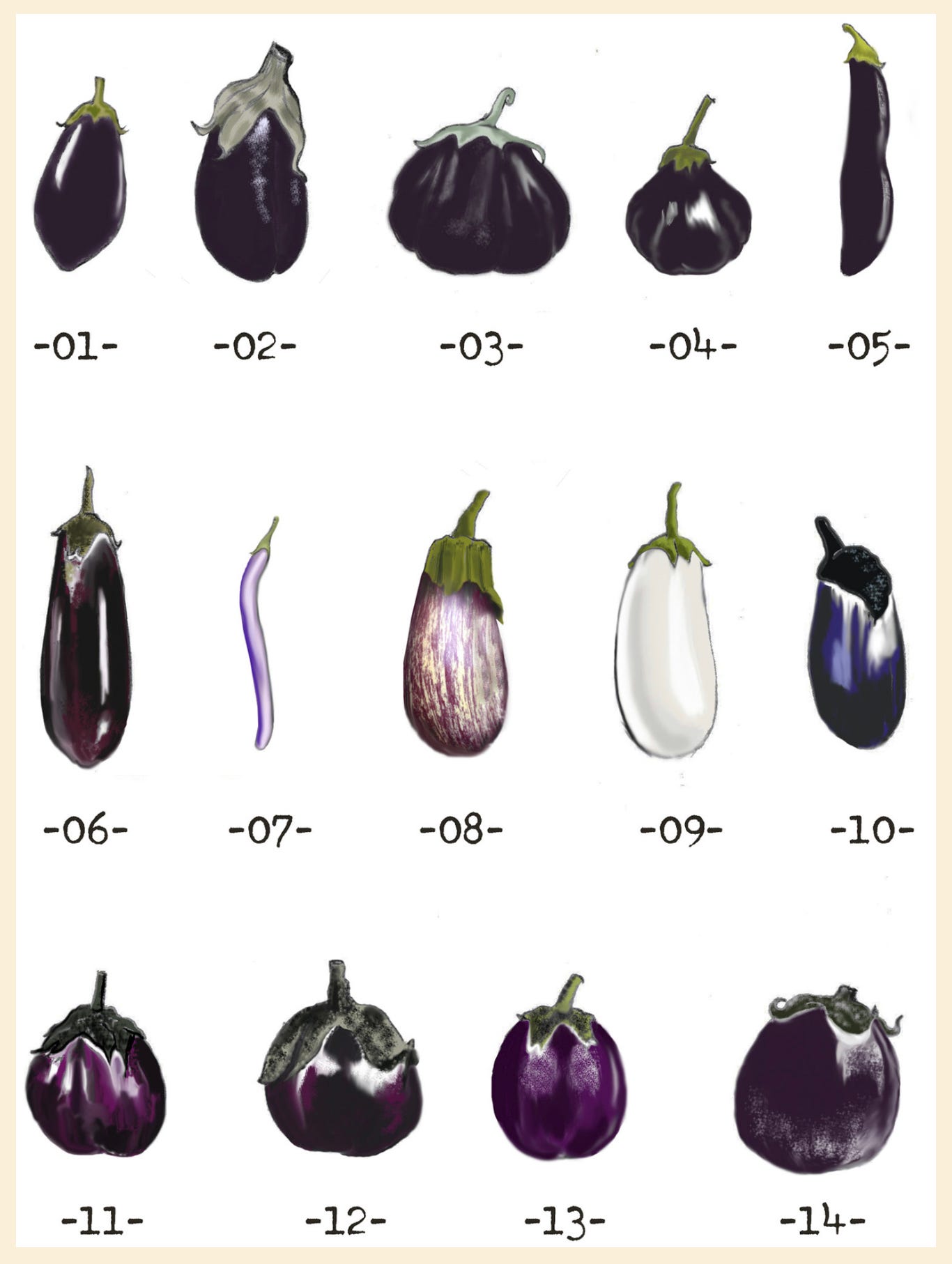



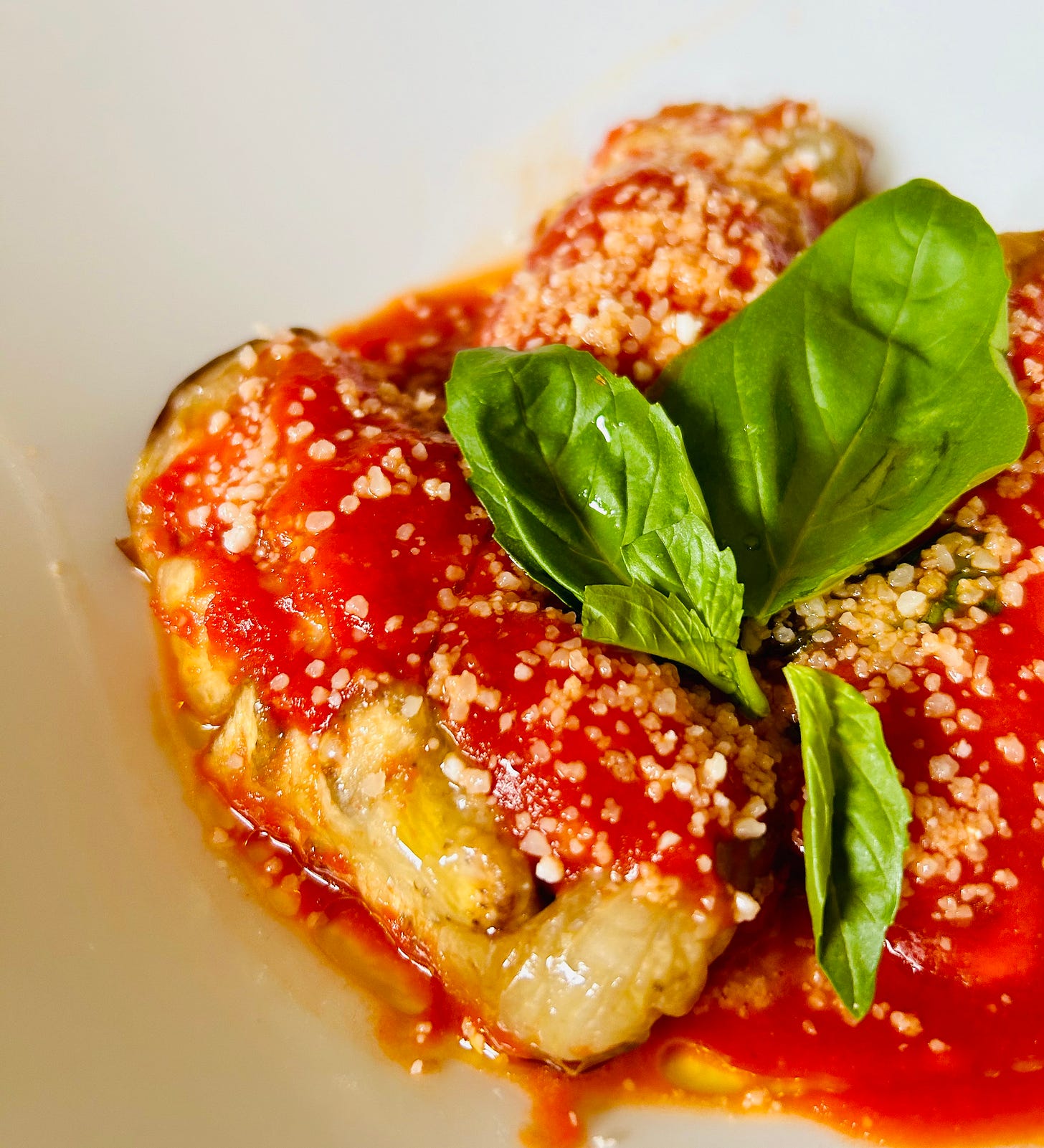
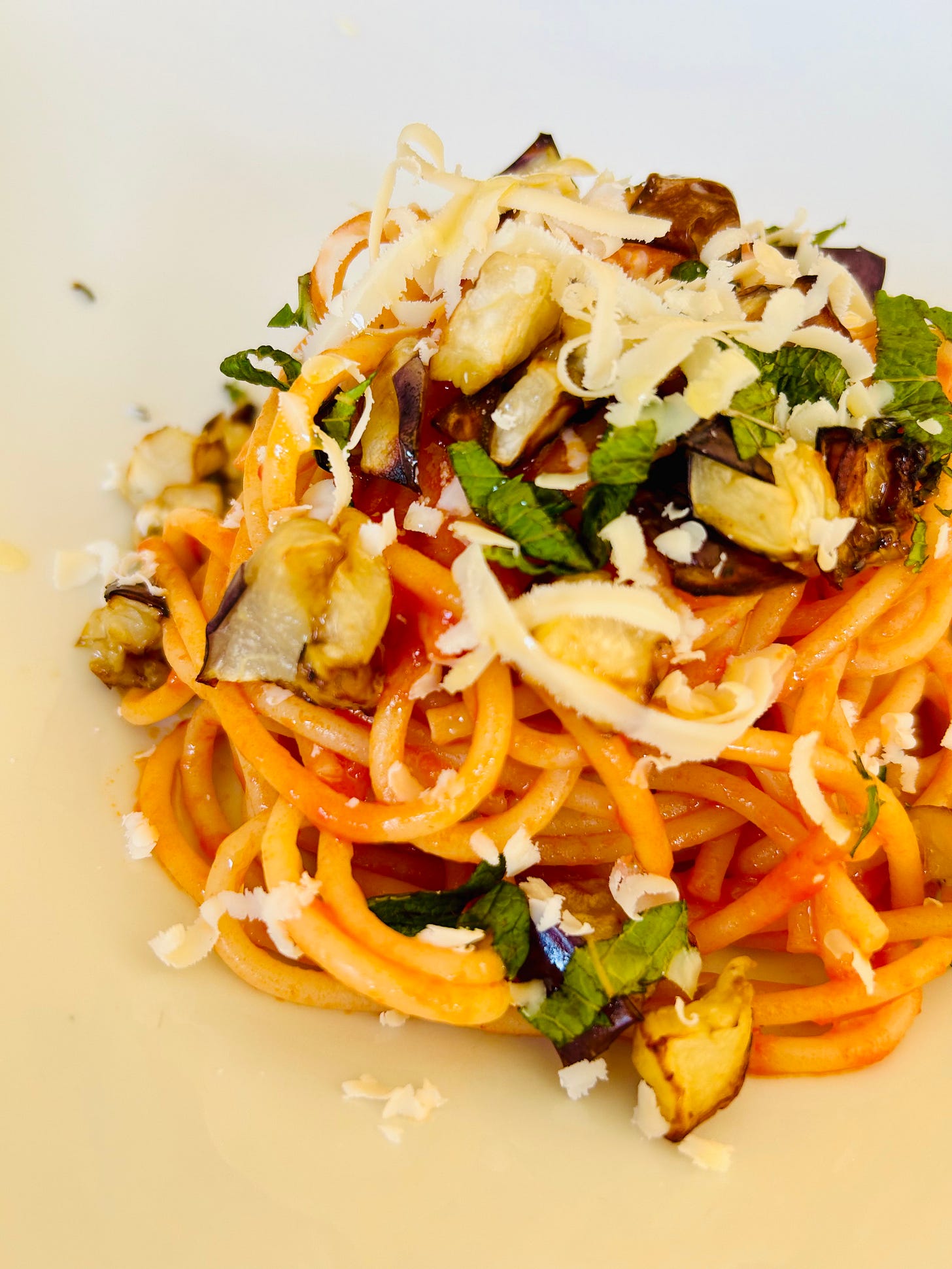

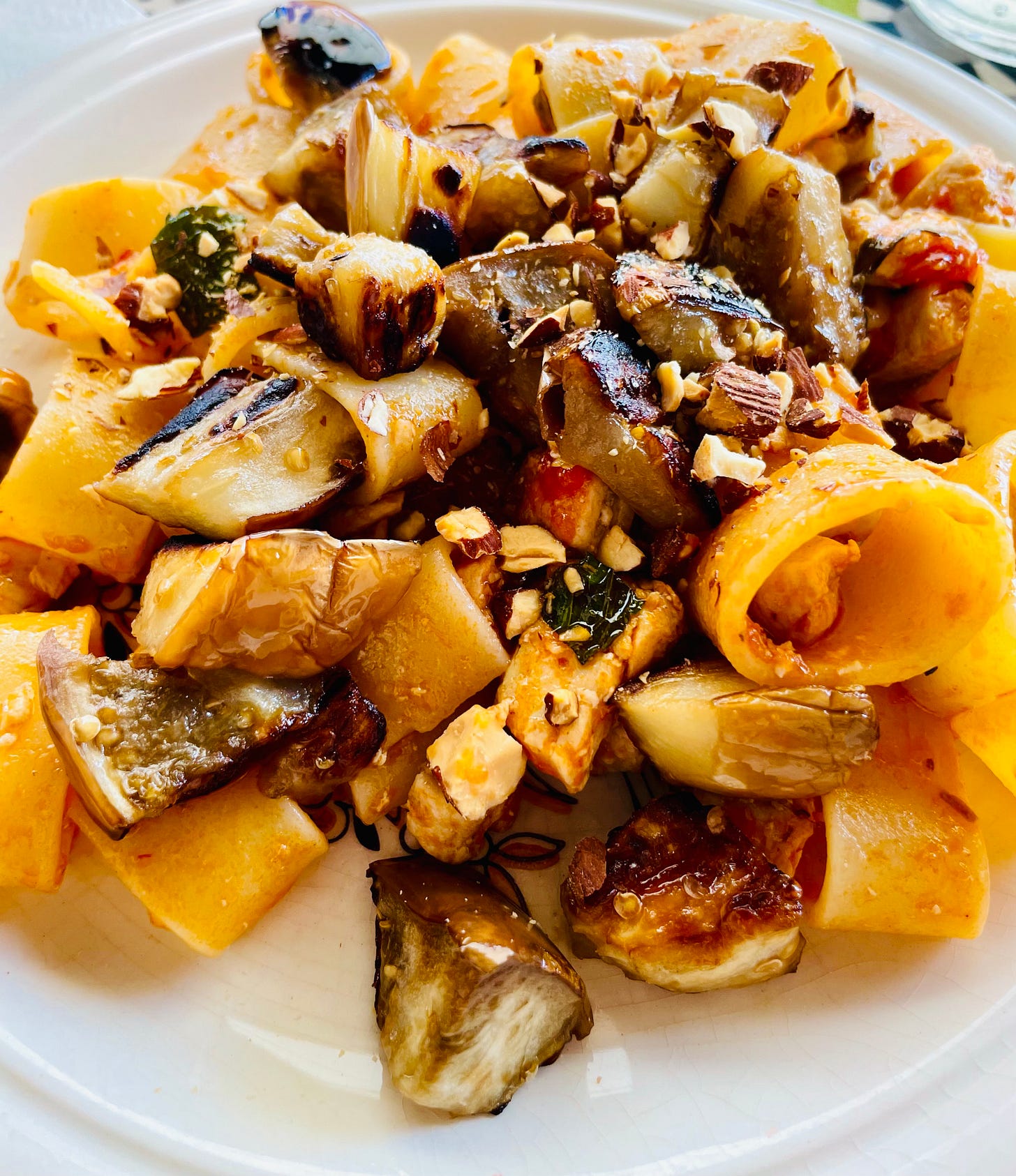

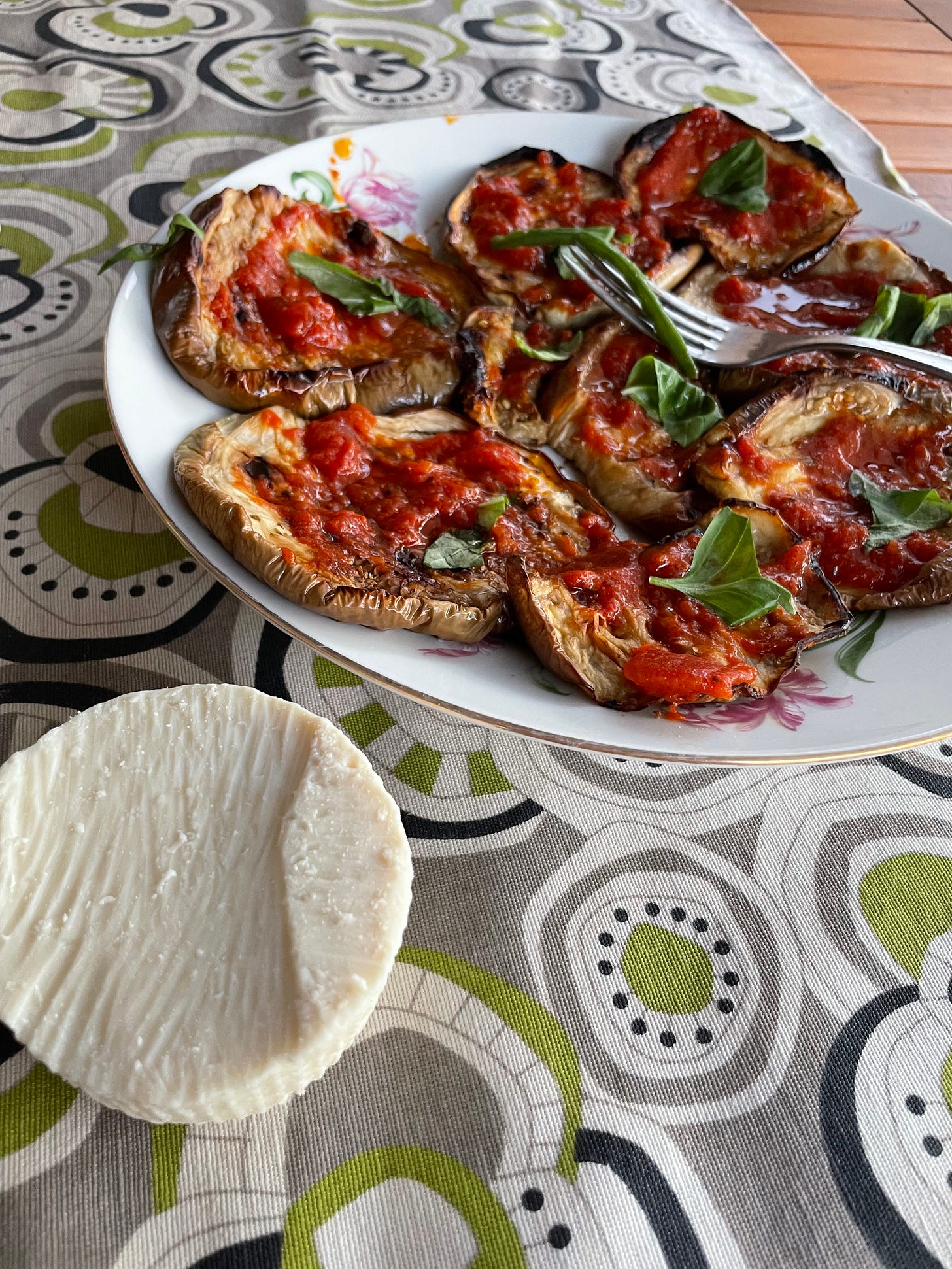
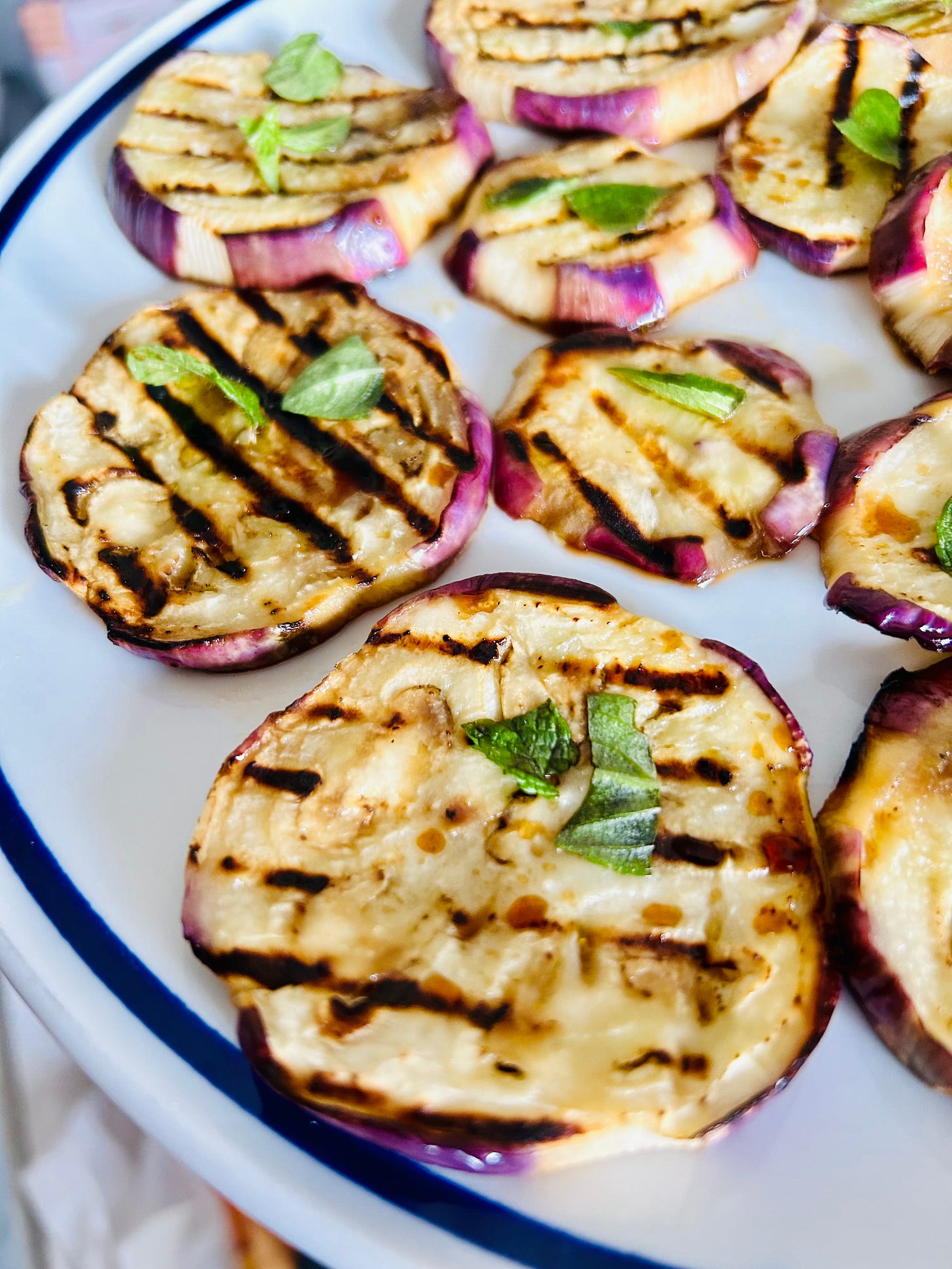
Aloha Francesco, I use a recipe from the internet that basically makes baked french fries from eggplant. Seasoned flour, egg wash, and Panko/paremsan; arranged on a mesh baking rack, 425F for 15 minutes! Serve with favorite dipping sauce...sweet chili sauce with chives, basil, green onion and mint. PS - I grow Calliope eggplant...small round and zebra striped. Very mild flavor.
Wonderful, Francesco! More plants to try in our garden 🙂. Very hard to find seeds in the US, only lunga so far. The daterino tomatoes here are coming along quite well. Can't wait!